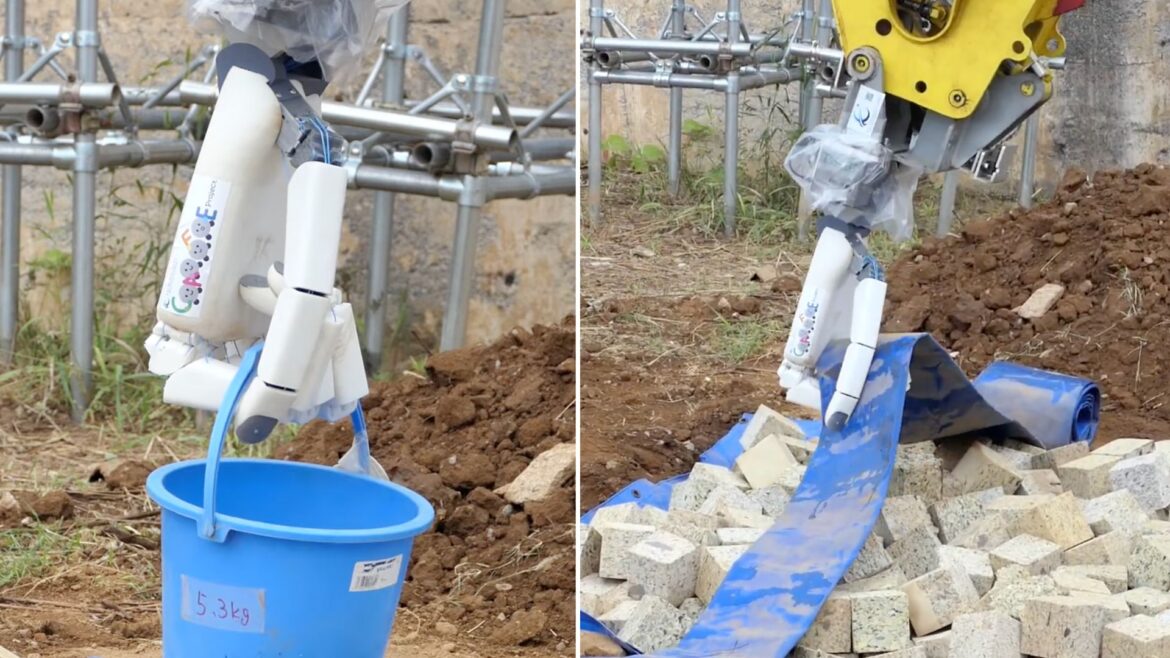Researchers in Japan and Switzerland have revealed a giant robotic hand that could transform how communities prepare for and recover from natural disasters.
Built through a collaboration between Kumagai Gumi, Tsukuba University, Nara Institute of Science and Technology, and ETH Zurich, the machine combines advanced robotics with artificial intelligence to tackle dangerous cleanup work that would normally put human workers at serious risk.
The project, called CAFE (Collaborative AI Field Robot Everywhere), is funded by Japan’s Cabinet Office and the Japan Science and Technology Agency.
It has been in development for five years and is designed to bring safety and precision to disaster zones filled with unstable debris, flooded areas, and collapsed cliffs.
A giant robotic hand built for chaos
The robot hand stands out because it can adapt its grip to whatever it picks up. Developed with expertise from ETH Zurich’s soft robotics research, it was designed to handle both fragile and heavy objects with equal skill. This is achieved using pneumatic actuators, which act like air-powered muscles.
Sensors in the fingertips and palm feed information to the system in real time, allowing the hand to decide how tightly or gently to hold an object. At a demonstration in Tsukuba, the hand picked up soft foam blocks and jagged metal pieces without damage or loss of control.
It could instantly switch from a light, careful grip to a firm hold, proving its ability to handle unpredictable disaster debris.
The hand is also durable enough to operate in demanding environments such as eroded riverbeds or blocked valleys. With a weight limit of 3 tons, the apparatus can be deployed into areas where traditional heavy equipment cannot reach.
This mobility gives rescue operations a safer and more effective option for clearing obstacles in remote or hazardous terrain.
Taking on natural dams with AI-driven excavation
One of the major problems the project aims to solve is the formation of natural dams. When landslides caused by earthquakes or heavy rainfall block rivers, entire communities face flooding risks.
Traditionally, workers had to manually dig channels or set up pumps in dangerous conditions, as seen after the Niigata-Chuetsu earthquake in 2004.
The CAFE team’s solution is to combine the robotic hand with an AI-driven excavation system. Researchers at Nara Institute of Science and Technology developed this software using Sim-to-Real reinforcement learning.
The AI first trains in digital simulations, learning to dig, identify obstacles, and adjust actions. Once tested, it applies those skills in real-world disaster environments.
Instead of following fixed commands, the system learns and adapts in real time. It decides how deep to dig, how much pressure to apply, and how to remove hidden objects without destabilizing the environment.
This adaptive approach is crucial when working in unpredictable conditions where traditional machinery or human labor would be unsafe.
From controlled tests to real-world deployment
The August 2025 demonstration in Tsukuba showcased the project at Technology Readiness Level (TRL) 4, proving that the robotic hand and AI could function in a controlled environment.
The next goal is TRL 5, which means showing it can operate under more realistic conditions. By November 2025, the team aims to be ready for real-world testing and eventual deployment.
The collaboration combines strengths from multiple fields. Kumagai Gumi provides practical expertise in construction and heavy equipment. ETH Zurich contributes advanced robotics design, particularly in soft robotics.
Tsukuba University and Nara Institute of Science and Technology focus on integrating artificial intelligence, making the system an autonomous problem-solver rather than just a tool.
If successful, the robotic hand could become vital to disaster management strategies worldwide. From clearing blocked rivers to carefully removing debris after earthquakes, the machine is designed to reduce risks to human workers and speed up recovery operations.


AloJapan.com